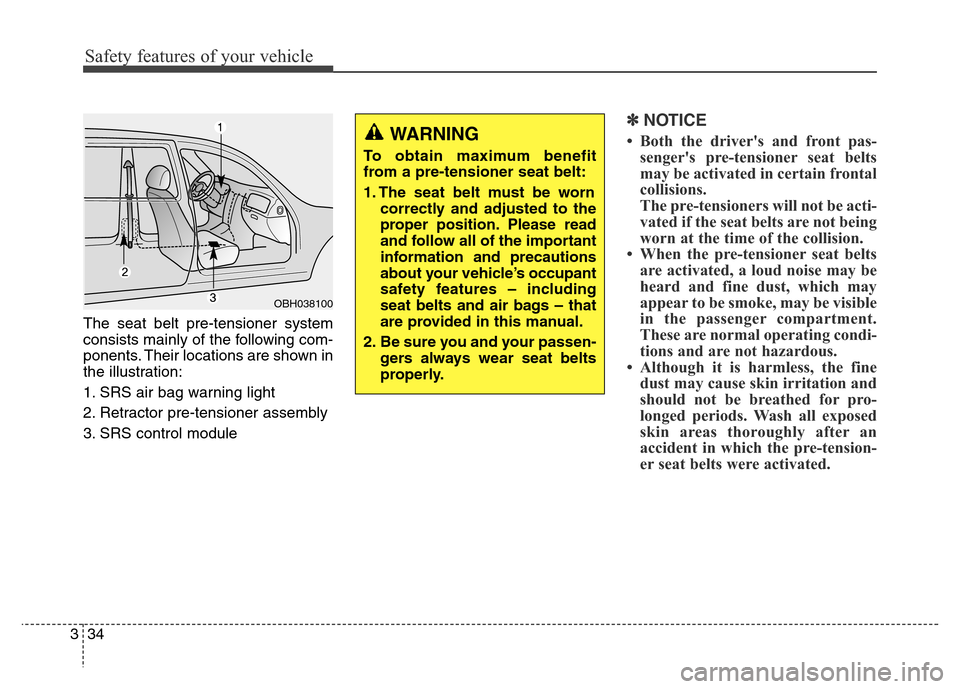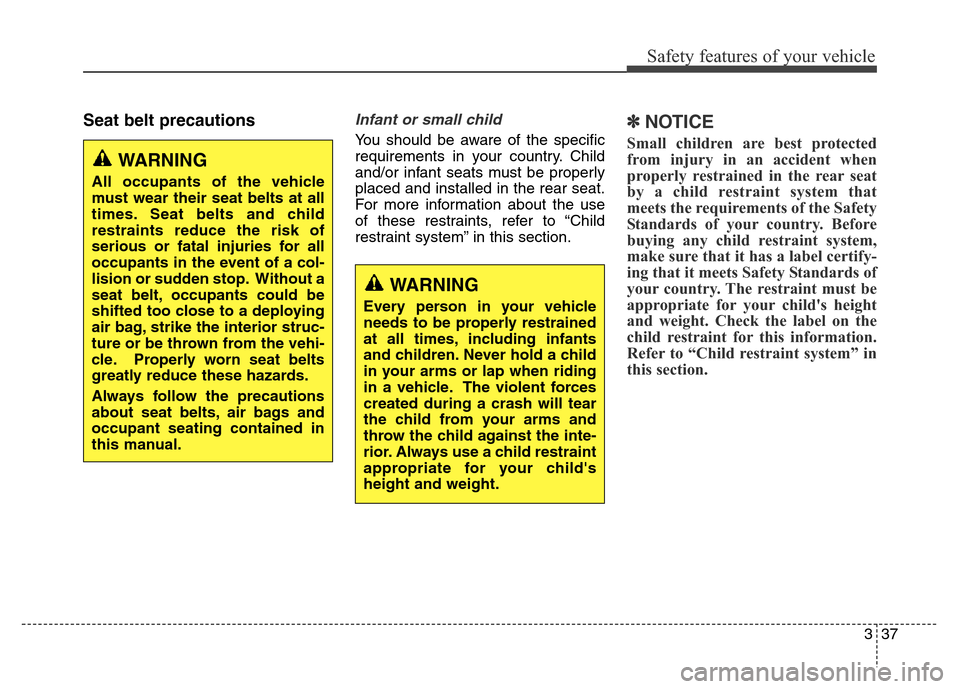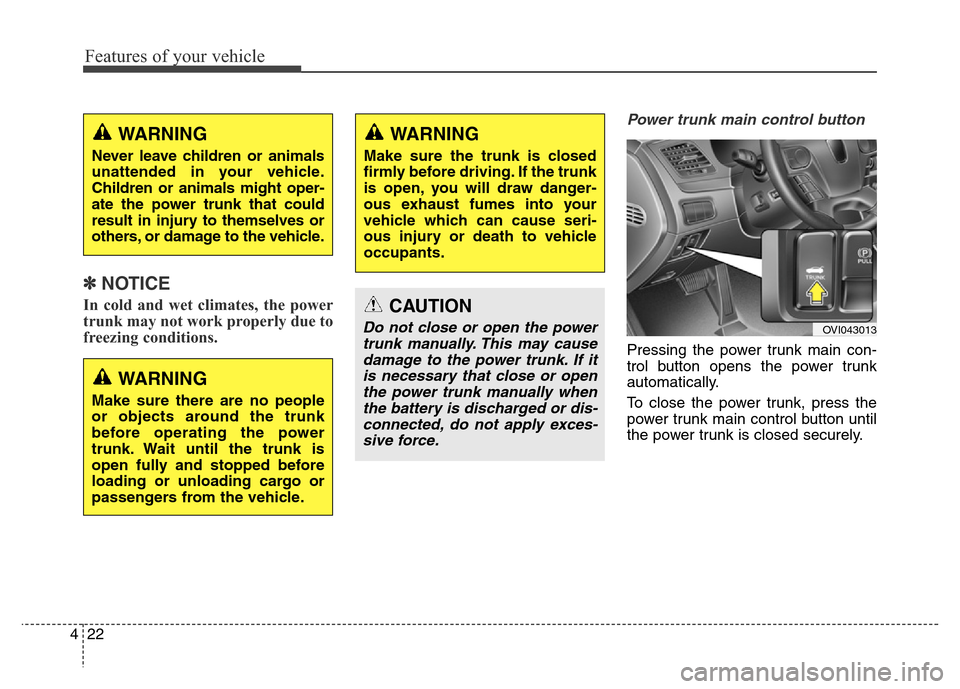2014 Hyundai Equus Manual ty
[x] Cancel search: Manual tyPage 51 of 479

Safety features of your vehicle
32 3
Lap belt (if equipped)
To fasten your seat belt:
To fasten a 2-point static type belt,
insert the metal tab (1) into the lock-
ing buckle (2). There will be an audi-
ble "click" when the tab locks into the
buckle. Check to make sure the belt
is properly locked and that the belt is
not twisted.
With a 2-point static type seat belt, the
length must be adjusted manually so
it fits snugly around your body. Fasten
the belt and pull on the loose end to
tighten. The belt should be placed as
low as possible on your hips, not on
your waist. If the belt is too high, it
could increase the possibility of your
being injured in an accident.When using the rear center seat belt,
the buckle with the “CENTER” mark
must be used.
OVI039066
OVI039064
OHM039105N
B220B01NF/H
Too high
ShortenCorrect
Lengthen
Shorten
Page 53 of 479

Safety features of your vehicle
34 3
The seat belt pre-tensioner system
consists mainly of the following com-
ponents. Their locations are shown in
the illustration:
1. SRS air bag warning light
2. Retractor pre-tensioner assembly
3. SRS control module
✽NOTICE
• Both the driver's and front pas-
senger's pre-tensioner seat belts
may be activated in certain frontal
collisions.
The pre-tensioners will not be acti-
vated if the seat belts are not being
worn at the time of the collision.
• When the pre-tensioner seat belts
are activated, a loud noise may be
heard and fine dust, which may
appear to be smoke, may be visible
in the passenger compartment.
These are normal operating condi-
tions and are not hazardous.
• Although it is harmless, the fine
dust may cause skin irritation and
should not be breathed for pro-
longed periods. Wash all exposed
skin areas thoroughly after an
accident in which the pre-tension-
er seat belts were activated.
OBH038100
WARNING
To obtain maximum benefit
from a pre-tensioner seat belt:
1. The seat belt must be worn
correctly and adjusted to the
proper position. Please read
and follow all of the important
information and precautions
about your vehicle’s occupant
safety features – including
seat belts and air bags – that
are provided in this manual.
2. Be sure you and your passen-
gers always wear seat belts
properly.
Page 56 of 479

337
Safety features of your vehicle
Seat belt precautionsInfant or small child
You should be aware of the specific
requirements in your country. Child
and/or infant seats must be properly
placed and installed in the rear seat.
For more information about the use
of these restraints, refer to “Child
restraint system” in this section.
✽NOTICE
Small children are best protected
from injury in an accident when
properly restrained in the rear seat
by a child restraint system that
meets the requirements of the Safety
Standards of your country. Before
buying any child restraint system,
make sure that it has a label certify-
ing that it meets Safety Standards of
your country. The restraint must be
appropriate for your child's height
and weight. Check the label on the
child restraint for this information.
Refer to “Child restraint system” in
this section.
WARNING
All occupants of the vehicle
must wear their seat belts at all
times. Seat belts and child
restraints reduce the risk of
serious or fatal injuries for all
occupants in the event of a col-
lision or sudden stop. Without a
seat belt, occupants could be
shifted too close to a deploying
air bag, strike the interior struc-
ture or be thrown from the vehi-
cle. Properly worn seat belts
greatly reduce these hazards.
Always follow the precautions
about seat belts, air bags and
occupant seating contained in
this manual.
WARNING
Every person in your vehicle
needs to be properly restrained
at all times, including infants
and children. Never hold a child
in your arms or lap when riding
in a vehicle. The violent forces
created during a crash will tear
the child from your arms and
throw the child against the inte-
rior. Always use a child restraint
appropriate for your child's
height and weight.
Page 62 of 479

343
Safety features of your vehicle
Installing a child restraint system
by lap belt (on the center rear
seat) (if equipped)
To install a child restraint system on
the center rear seats, do the follow-
ing:
1. Place the child restraint system on
the center rear seat.
2. Extend the latch plate tongue of
the lap belt.
3. Route the lap belt through the
restraint according to the seat
manufacturer’s instructions.4. Buckle the seat belt and adjust the
lap belt for a snug hold on the child
restraint by pulling on the loose
end of the belt. After installation of
the child restraint system, try to
move it in all directions to be sure
the child restraint system is
securely installed.
1GHA2260/H
(Continued)
• If the seat belt does not oper-
ate as described in this sec-
tion, we recommend that the
system be checked by an
authorized HYUNDAI dealer.
• Failure to observe this manu-
al's instructions regarding
child restraint systems and
the instructions provided with
the child restraint system
could increase the chance
and/or severity of injury in an
accident.
• If the vehicle headrest pre-
vents proper installation of a
child seat (as described in the
child seat system manual), the
headrest of the respective
seating position shall be read-
justed or entirely removed.
Page 66 of 479

347
Safety features of your vehicle
Securing a child restraint system
with “ISOFIX” system and “Tether
Anchorage” system (if equipped)
ISOFIX is a standardised method of
fitting child seats that eliminates the
need to use the standard adult seat
belt to secure the seat in the vehicle.
This enables a much more secure
and positive location with the added
benefit of easier and quicker installa-
tion.
An ISOFIX-seat can only be installed
if it has vehicle-specific approval in
accordance with the requirements of
ECE-R44.There is a child restraint symbol
located on the lower portion of each
side of the rear seatbacks. These
symbols indicate the position of the
lower anchors for child restraints so
equipped.
On each side of the rear seat,
between the cushion and backrest,
are located a pair of ISOFIX anchor-
age points together with a top tether
mounting on the shelf behind the
rear seats. During the installation,
the seat has to be engaged at the
anchorage-points in a way you can
hear it clicking (check by pulling!)
and has to be fixed with the Top
Tether-belt on the belonging point on
the shelf behind rear seats.The installing and the use of a child-
seat has to be done according to the
installing-manual, which is added to
the ISOFIX-seat.
OVI039060
OVI033036
ISOFIX Anchor
ISOFIX Anchor
Position Indicator
WARNING
Install the child restraint seat
fully rearward against the seat-
back with the seatback in a ver-
tical position, not reclined.
Page 77 of 479

Safety features of your vehicle
58 3
The SRS consists of air bags
installed under the pad covers in the
center of the steering wheel , in the
knee bolster below the steering
wheel column and the passenger's
side front panel above the glove box.
The purpose of the SRS is to provide
the vehicle's driver and/or the front
passenger with additional protection
than that offered by the seat belt sys-
tem alone in case of a frontal impact
of sufficient severity. The SRS uses
sensors to gather information about
the driver's seat position, the driver's
and front passenger's seat belt
usage and impact severity.The seat belt buckle sensors (if
equipped) determine if the driver and
front passenger's seat belts are fas-
tened. These sensors provide the
ability to control the SRS deployment
based on whether or not the seat
belts are fastened, and how severe
the impact is.
OVI033041
Passenger’s front air bag
WARNING
Always use seat belts and child
restraints – every trip, every
time, everyone! Air bags inflate
with considerable force and in
the blink of an eye. Seat belts
help keep occupants in proper
position to obtain maximum
benefit from the air bag. Even
with air bags, improperly belted
and unbelted occupants can be
severely injured when the air
bag inflates. Always follow the
precautions about seat belts, air
bags and occupant safety con-
tained in this manual.
To reduce the chance of serious
or fatal injuries and receive the
maximum safety benefit from
your restraint system:
• Never place a child in any
child or booster seat in the
front seat.
(Continued)
Page 106 of 479

417
Features of your vehicle
Power door latch (if equipped)
If a door isn’t closed completely but
is closed to the first detent position,
the door will be close automatically.
Operating door locks from
inside the vehicle
With the door lock button
• To unlock a door, push the door
lock button (1) to the “Unlock” posi-
tion. The red mark (2) on the button
will be visible.
• To lock a door, push the door lock
button (1) to the “Lock” position. If
the door is locked properly, the red
mark (2) on the door lock button
will not be visible.
• To open a door, pull the door han-
dle (3) outward.• If the inner door handle of the dri-
ver’s (or front passenger’s) door is
pulled when the door lock button is
in lock position, the button is
unlocked and door opens. (if
equipped)
• Front doors cannot be locked if the
smart key is in the vehicle and any
door is opened.
OVI049008
Lock
Unlock
OVI043007
WARNING
If the door is open slightly, be
careful not to nip fingers in the
door.
CAUTION
Before closing the door, ensure
that all obstructions are removed.
WARNING - Door lock
malfunction
If a power door lock ever fails to
function while you are in the
vehicle, try one or more of the
following techniques to exit:
• Operate the door unlock fea-
ture repeatedly (both electron-
ic and manual) while simulta-
neously pulling on the door
handle.
• Operate the other door locks
and handles, front and rear.
• Lower a front window and use
the key to unlock the door
from outside.
Page 111 of 479

Features of your vehicle
22 4
✽NOTICE
In cold and wet climates, the power
trunk may not work properly due to
freezing conditions.
Power trunk main control button
Pressing the power trunk main con-
trol button opens the power trunk
automatically.
To close the power trunk, press the
power trunk main control button until
the power trunk is closed securely.
WARNING
Make sure there are no people
or objects around the trunk
before operating the power
trunk. Wait until the trunk is
open fully and stopped before
loading or unloading cargo or
passengers from the vehicle.
WARNING
Make sure the trunk is closed
firmly before driving. If the trunk
is open, you will draw danger-
ous exhaust fumes into your
vehicle which can cause seri-
ous injury or death to vehicle
occupants.
CAUTION
Do not close or open the power
trunk manually. This may cause
damage to the power trunk. If it
is necessary that close or open
the power trunk manually when
the battery is discharged or dis-
connected, do not apply exces-
sive force.OVI043013
WARNING
Never leave children or animals
unattended in your vehicle.
Children or animals might oper-
ate the power trunk that could
result in injury to themselves or
others, or damage to the vehicle.